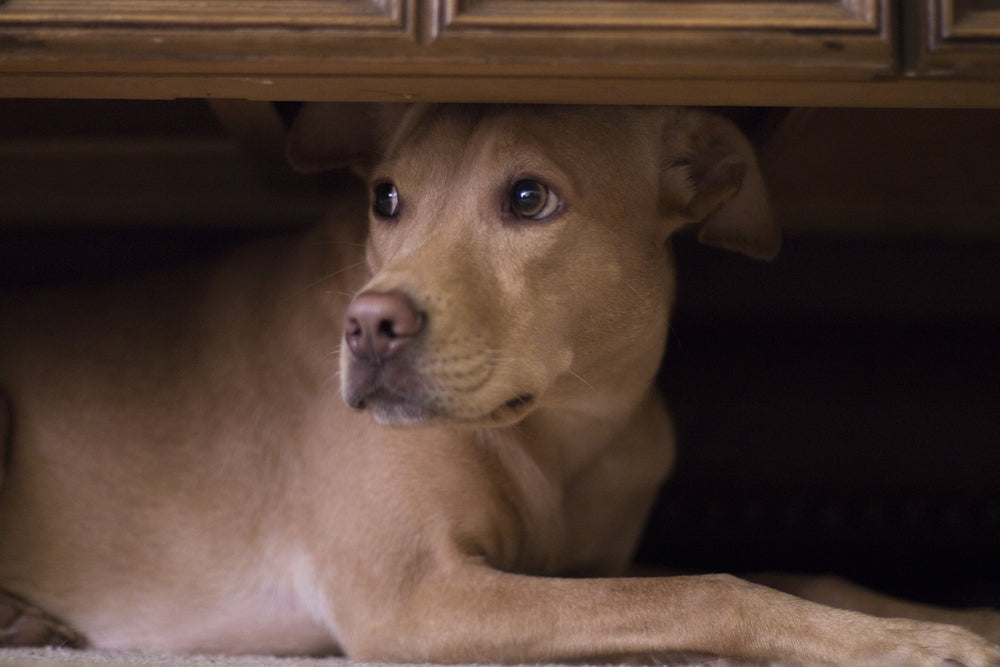Understanding Canine Anxiety: Recognizing and Managing Stress in Dogs
Posted by Jackie Ly on Jan 12, 2024

Just like humans, dogs get stressed when confronted with new environments, people, animals, objects, or situations. No matter how nice your guest is, how cute the new kitten in your house is, or how soundproof you’ve made the house to muffle the New Year’s fireworks, you can never truly rule out the possibility of your dog reacting negatively to something they’re not used to.
Learning what turns your dog into an anxious ball of fur, combined with the right training, will be the key to a happy dog.
Signs of a stressed dog
The trick to becoming an expert in interpreting canine communication is to consider the context. What does their environment look like? Have they eaten yet? Is there anything around them they might be reacting to? Take a look at the whole picture to see what’s stressing out your pup.
Yawning: Unless they’re feeling sleepy, a yawn can be seen as a self-calming gesture, an action a dog does when they’re feeling particularly stimulated—that is, they may be excited or stressing out over something.
Panting: Some people often fan themselves when they’re feeling worked up about something. Dogs do the same thing, as panting is a way for them to cool their internal body temperature.
If they haven’t just come in from an exciting training session or finished a quick sprint around the house, and if their tongue appears curled at the tip instead of relaxed, it’s likely that they’re feeling stressed.
Pacing back and forth: Again, this isn’t all that different from how humans pace back and forth when they’re pondering, or are anxious about something! When you catch your canine companion flitting back and forth across the room, take a look around to see what’s gotten them all worked up about.
Licking their lips, or licking a lot more than usual: No, your dog probably hasn’t seen the homemade chow you’ve made them. Licking is another self-calming gesture that dogs also use as a form of submission, so it’s a possible sign that your dog is trying to appease something or someone that’s making them feel threatened.
Excessive shedding: It’s snowing! Snowing dog fur, that is. When you find your pup’s brush has more hair than usual, or if you notice bald patches, consider a few scenarios: that they’re reacting badly to their shampoo or soap, they’ve eaten something they’re allergic to, or they’re feeling particularly anxious.
Ears pinned back: Popularly known as going “aeroplane mode”, a dog with its ears flattened against the back of their head, often combined with cowering, is a dog reacting negatively to something and responding with submission.
Whale eyes: Yet another gesture that has more or less the same meaning as its human counterpart! If you’ve ever seen your furry friend look at you out of the corner of their eye, they’re probably feeling distressed about something.
Or, they know they’ve done something wrong and are worried you’ll find out. It probably has nothing to do with the ripped up cushions in your living room—nothing at all.
Dogs react to something distressing in different ways. The more stressed a dog becomes, however, the more drastic their reactions are. An extremely stressed dog may:
- Back away, cowering, with tail tucked between their legs: In response to stress, a dog may do these appeasing gestures. When your dog does these, they are attempting to make themselves smaller and less of a threat, in the hopes that whatever’s scaring them will leave them alone.
- Accidentally pee or poop: Your pup might lose control of their bathroom etiquette when the stress levels hit the ceiling. This may happen even if your dog has already been house-trained!
- Snap or even bite: While some dogs may take the appeasement route when they’re stressed, others may do the complete opposite: they lash out. A cornered dog is said to be as dangerous as a wounded one, so take extreme caution the minute you see your dog growling—a warning that they will most definitely bite.
- Experience a loss of appetite: When your dog is eating less than usual, or they’re not eating at all, immediately take them down to the vet. This may be a sign of an underlying illness.
How to manage or calm a stressed dog
You’re seeing your dog show signs of being stressed. What do you do about it now?
However, take caution when you do this: remember, an extremely stressed dog is also extremely likely to snap!
No one enjoys seeing a dog being down in the dumps, let alone being distressed and anxious. Recognizing those stress signals and throwing in a mix of positive reinforcement, toys, and calming vibes helps you create a canvas of comfort for your beloved companion.
Whether your pup is confronted with a new experience or faced with the unexpected, your role is to be that guiding star that transforms stress into nothing but paw-sitive vibes.
